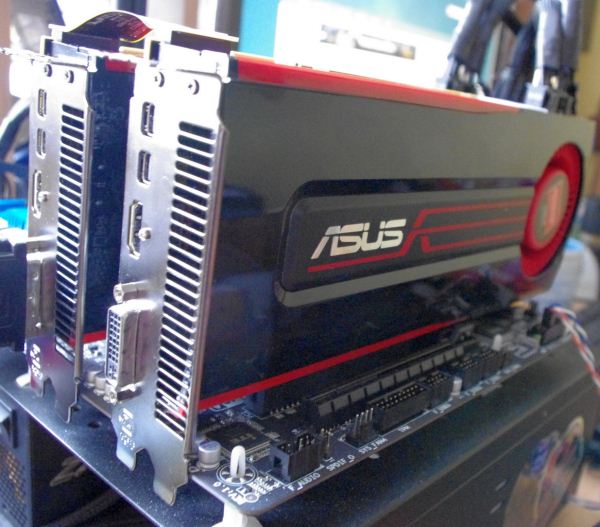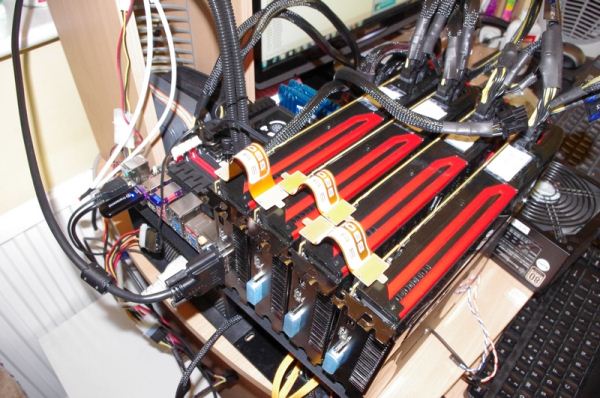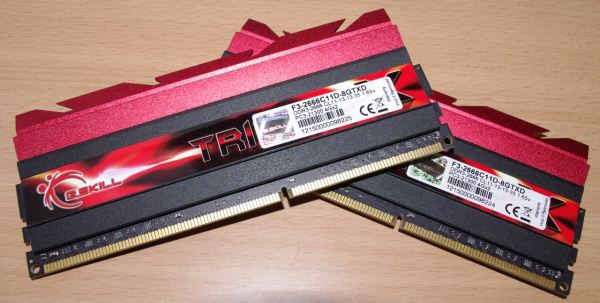Intel Z77 Motherboard Review with Ivy Bridge - ASRock, ASUS, Gigabyte, and MSI
by Ian Cutress on May 7, 2012 7:40 PM EST- Posted in
- Motherboards
- MSI
- Gigabyte
- ASRock
- Asus
- Ivy Bridge
- Z77
Updates to our Testing Methodology
In light of various requests and as a naturally evolving process, some of our motherboard tests have changed. This has the unfortunate consequence of making many of our previous results incomparable, but if they were never updated, we would still be on Catalyst 6.3 or something similar! Also with experience allows us to pick tests that are able to run and give a nice score without having to sit with a stopwatch for twenty minutes each time.
For our CPU tests, we introduce Xilisoft Video Converter, a tool used to convert one type of video to another. What I like about XVC is that it works using all threads available as much as it can, and if you have a GPU that is compatible, it will use it to help speed up conversion. We also add in x264 HD Benchmark, a standard video encoding benchmark that a few other review websites use.
For the system benchmarks, we utilize two new features for USB testing. In terms of hardware, we use a SATA 6 Gbps to USB 3.0 device connected up to an OCZ Vertex3 240 GB drive in order to really stress both USB 2.0 and USB 3.0. For this test, we are also using software called DiskBench - a utility that records accurate times to copy from one drive through the USB to another.
Our GPU test suite also gets a bump. Previously all benchmarks were run at 1920x1080, a reasonable gaming screen size. Today we move all our benchmarks up to 2560x1440 using a 27" Yamakasi Catleap Q270 LED, a common Korean gaming monitor. In terms of actual GPUs, we are retiring our now two generations old HD 5850s, and with many thanks to ASUS, now using a set of HD 7970s for up to four-way CrossFireX (should the motherboard allow it). For NVIDIA, we still use a pair of ECS GTX 580s for SLI testing. The games are also changing with AVP becoming a relatively trivial (120 FPS+) benchmark at 1920x1080, so we are replacing it with Civilization 5 at 2560x1440.
Test Setup
| Processor |
Intel Core i7-3770K ES 4 Cores, 8 Threads, 3.5 GHz (3.9 GHz Turbo) |
| Motherboards |
ASRock Z77 Extreme4 ASUS P8Z77-V Pro Gigabyte GA-Z77X-UD3H MSI Z77A-GD65 |
| Cooling | Intel All-in-One Liquid Cooler |
| Power Supply | OCZ 1250W Gold ZX Series |
| Memory |
GSkill RipjawsZ 4x4 GB DDR3-2400 10-12-12 Kit GSkill TridentX 2x4 GB DDR3-2666 11-13-13 Kit |
| Memory Settings | XMP (1866 9-10-9) |
| Video Cards |
ASUS HD7970 3GB ECS GTX 580 1536MB |
| Video Drivers |
Catalyst 12.3 NVIDIA Drivers 296.10 WHQL |
| Hard Drive | Micron RealSSD C300 256GB |
| Optical Drive | LG GH22NS50 |
| Case | Open Test Bed - CoolerMaster Lab V1.0 |
| Operating System | Windows 7 64-bit |
| SATA Testing | Micron RealSSD C300 256GB |
| USB 2/3 Testing | OCZ Vertex 3 240GB with SATA->USB Adaptor |
Many thanks to...
Many thanks to ASUS as they have kindly allowed us to retire our now two generations old HD 5850s. By providing us with a set of ASUS HD 7970s for up to four-way CrossFireX, we can really test any system that comes our way (coupled with that 2560x1440 monitor).
The ASUS HD7970-3GD5 was ASUS' first 7970 product on the market, using the reference design but being coupled with ASUS GPU Tweak software and support. These cards offer solid performance, and I have easily overclocked them from 925/1375 to 1200/1800 with small bumps in voltage. With any luck, the limiting factor for the next few generations of motherboards will be the motherboard rather than our GPU in the GPU testing, as well as some special X79 boards we are testing soon.
A little preview of some overclocking I have done with these cards for a future review
Many thanks should also go to G.Skill, for sending us one of their new TridentX memory kits designed specifically for the Z77 Platform. The kit they have sent is the F3-2666C11D-8GTXD, or put simply, a dual channel 8 GB kit (two 4 GB modules) designed to run at DDR3-2666 MHz with 11-13-13-35 timings at 1.65 volts.
Having DDR3-2666 memory does seem a little far-fetched, given that Panther Point and the CPUs are only rated up to DDR3-1600. However, with the integrated memory controller on Ivy Bridge, most motherboards should support up to DDR3-2666 to DDR3-2800 by default. In the real world, this means that bulk memory transfers, or memory transfer limited situations, should get a boost. This is in the realm of video processing, or integrated graphics gaming, or multi-monitor gaming (depending on how the game is processed). However, given that motherboard manufacturers are releasing the fact that their motherboards should support these high frequencies, it does not hurt to test them!
In terms of G.Skill’s part in all this – their TridentX range will cover dual channel kits and quad channel kits, from 2x4 GB kits, 2x8 GB kits, 4x4 GB kits and to 4x8 GB kits. The smaller 4 GB module kits will have speeds from 2400 to 2800 MHz, and are assured to be competitively priced, as well as overclockable. In terms of our 2x4 GB 2666 11-13-13 kit, we were able to bump up the ratio to 2800 MHz without any change of voltage or subtimings. With a little voltage push, we were able to go to 2950 MHz with some frequency adjustments. As long as the CPU can take it, it seems that G.Skill have some overclockable kits ready for the taking.














117 Comments
View All Comments
drbuzbee - Thursday, May 10, 2012 - link
The Lan read and write sequential speeds are labeled MBytes ps but undoubtedly are reported in Mbits ps.millisec - Thursday, May 10, 2012 - link
The Gigabyte UD3 is a nice board but it's a little annoying that's the board GB keeps sending out for reviews because of the $160 price mark. For $29 more you get so much more in the UD5 with Realtek audio, dual lan with Intel/Atheros, PCI 3.0 X4 slot, more sata 3 ports and second Marvell raid controller. The extra $29 buys a lot vs. the UD3 and in IMO is a much better value. Just hoping the UD5 arriving today does not have the same problems with the G.Skill Ripjaws X 2400 kit Anand had. Won't be a happy camper...Zoomer - Tuesday, May 15, 2012 - link
$29 for extra sata ports = pass. ;)embeddedbill - Friday, May 11, 2012 - link
Hi Ian, any chance you will have an update on this board?embeddedbill - Friday, May 11, 2012 - link
What... Did that take about 3 minutes from this question to Anands article?smalM - Friday, May 11, 2012 - link
Black connectors, video ports, PS/2 - the first manufacturer who omits all that nonsense will get my money.KivBlue - Friday, May 11, 2012 - link
Gigabyte has gone cheap for sure, I have compared the specs for both on-board audio chips and Realtek clearly has more feature sets. Plus VIA interface looks hideous. My current system's motherboard is Gigabyte and while they have improved things with UEFI, the feature set they have in it is pretty much the same as the old BIOS, ASUS clearly has a more comprehensive UEFI in that regard, I would go with ASUS motherboard in the future as I'm no longer a novice and someone who wants to take full control of a system.bobster1 - Sunday, May 13, 2012 - link
I've been debugging crashes at stock and overclock for a few days and finally seem to have found the cause, and thought it was worth mentioning here as I didn't see anything about it in the article.I was finding my 7970 crossfire/UD3h/3770k setup was locking up frequently in games like the Witcher 2 - the system would freeze and had to be turned off and on again. I discovered by accident that the games became stable if I had prime95 running in the background, and eventually concluded that it must have something to do with the voltages at lighter loads. When I bumped up the voltage to 1.25v in the BIOS (using the static setting, rather than dynamic voltage), it seems to have solved the problem. I'm guessing this is due to Ivy Bridge taking responsibility for pci-e; it's rather unfortunate as it means I can't let the cpu use a lower voltage in an idle state without it rendering the system unstable when rendering 3d.
mikeyd55 - Tuesday, June 19, 2012 - link
Hi,First, thank you for addressing this important benchmark!
Your article notes that POST times can be improved by disabling non essential controllers.
It would be helpful to know, with the minimum controllers enabled to support a system built on either the PRO or DELUXE (Asus) boards, with: one NIC enabled in OS (only?), boot from one SSD and/or one optical drive connected to Z77 chipset ports (no third party storage controller needed), USB disabled on boot, but enabled in OS (if possible as with certain Intel boards?), and any Wireless option disabled, what could be expected.
Conditioned - Wednesday, June 20, 2012 - link
So how was dpc measured? If you disable intel-c state and all other powersaving features it makes an absolutely huge difference in dpc.